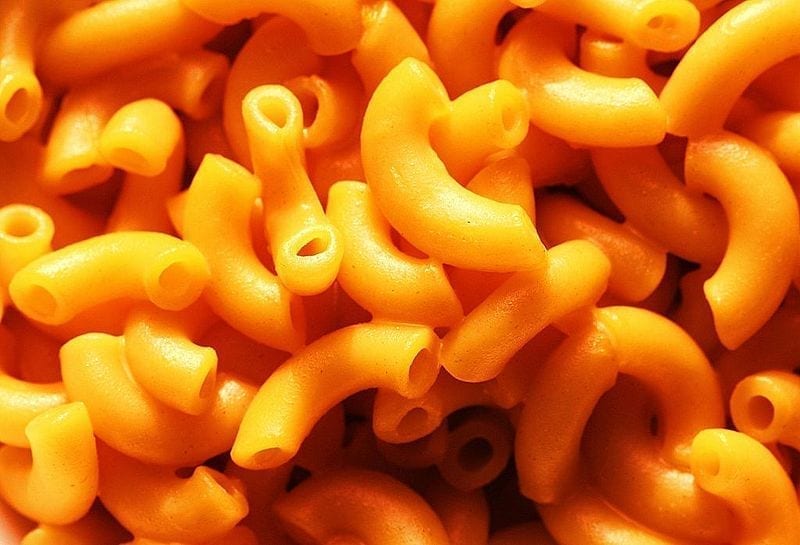Last week, the New York Times ran a story about the phthalates found in “high concentrations” in many common cheese products, including the beloved blue box of bright orange macaroni and cheese. But wait – there’s more! Or …less.
Last week, the New York Times ran a story about the phthalates found in “high concentrations” in many common cheese products, especially the iconic blue box of bright orange macaroni and cheese.
Phthalates are a class of industrial chemicals used to soften plastics, so they are found in soft vinyl PVC products like vinyl flooring, building materials, shower curtains, and some food processing equipment. Because phthalates are endocrine disrupting chemicals that can affect normal male development by blocking the production of testosterone, they’ve been phased out of products like children’s toys, teethers, and baby bottles. Phthalates bind with fats and can be absorbed into fatty foods like cheese or meat when machines with soft vinyl parts are used in processing, or if the foods are packaged in plastic.
That last bit is why several advocacy groups teamed up to fund a study on phthalates in cheese products. The study claims to have found phthalates in almost every cheese product tested, including natural block cheeses, shredded and string cheese, cottage cheese, and even the bright orange processed cheese powder that gives boxed macaroni and cheese that special color and flavor.
ConsumerWatch: Mac ‘n’ Cheese Danger, posted by CBS SF Bay Area
Macaroni and cheese seems to be a requirement when it comes to raising American children. “Buy lots of macaroni and cheese” was the second item in a “REAL Parenting Pro Tips” list published by the popular Scary Mommy blog, right under a suggestion to hide your candy stash in the laundry room. Seems legit.
So when the news dropped in online parenting communities that the beloved orange dish, maybe the only thing a kid would eat, is laced with phthalates, that news went over like a turd in the microwave. Considering that Kraft had dumped their artificial dyes just over a year ago, parents could be forgiven for expecting the extruded, foodlike product to be relatively safe. And now? Not only has it always seemed a bit like plastic cheese, now it seemed to be literally true.
But wait – there’s more! Or …less.
Like so many popular campaigns against isolated chemicals found in food (yoga mats and Subway bread come to mind), this one may not have the best science behind it. While it’s true that phthalates aren’t healthy to ingest, the way the study presented the findings was a bit skewed.
It turns out that the orange cheese powder tested in the study isn’t substantially higher in phthalates than any of the other cheeses tested, on a per-kilogram basis. The claim that the powdered orange stuff was measurably worse came from comparing the products on a per-fat basis, meaning that you’d have to consume only the fatty part of each tested cheese in order for the cheese powder to be so much worse. Who actually does that?
Cheese, like most other foods, doesn’t consist solely of fat. It also contains moisture, protein, and trace amounts of minerals. The circulated report did not present the total level of phthalates in each product, only in the fat present in each product. Without a good way to compare the tested cheese products to each other, or to know what concentration of phthalates is in the whole version of the food you’re eating, it’s difficult to know if the phthalates are present at a dangerous level, or to make the healthiest overall choice. Only when looking at the full study could one notice that none of the cheeses tested came close to the EU limits for phthalates in food.
It’s really hard to avoid eating phthalates and still live in the modern world. Not only is the processed food industry to blame for various forms of contamination as well as questionable nutrition, but simply microwaving food in plastic can cause phthalates to leach into your meal. Yet who among us tosses out every scratched plastic bowl, or stores all of our edibles solely in glass or stainless steel containers, as has been suggested?
Even better, of course, is to eat fresh fruits and vegetables, perhaps ones you raised yourself, and make sure your meats and cheeses never touch plastic. (You can even make bright orange macaroni by mixing in some mashed squash. Who knew?) While this level of “clean eating” may well prove impossible for nearly everyone, poor outcomes continue to be blamed on personal choices as if everyone were able to raise 100% of their own food and simply choose not to.
And if that makes you want to swear, Kraft has you covered.


Join the conversation!